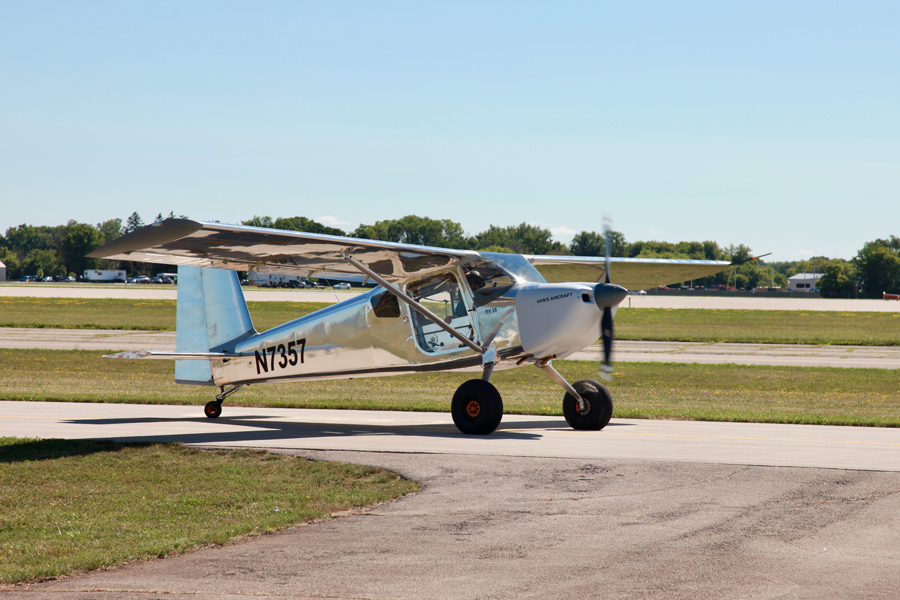RV-15
Robbie Culver


When Van’s Aircraft announced its first high-wing model, the RV-15, at AirVenture 2021, many in the experimental aircraft community were understandably shocked. The company had traditionally designed low-wing models only. On Monday, July 25, 2022, Van’s brought the aircraft out for public display at EAA AirVenture Oshkosh.
Rob Heap, EAA 824015, director of engineering for Van’s Aircraft, emphasized that there are no published specifications for what he described as a “pencil sketch in flight” designed to validate the design. With about 45 hours of test time completed, including the flight to Oshkosh, the stated goal was to test the aircraft safely, get it to Oshkosh, and get it home to Aurora, Oregon, again for further testing and modification. Heap emphasized Van’s “wants the airplane to be right before shipping kits to customers.”
The aircraft on display (described as an “engineering test article” by Heap) in Booth 604 of the Homebuilt Aircraft Display area is not the final form of the design, and kits are not available to order at this stage. The RV-15 is intended to focus on the STOL market. Company President Rian Johnson, EAA 600116, described the effort to finish, test, and fly the RV-15 to Oshkosh as an “amazing amount of work.”
Heap described the initial testing as tracking expectations in most areas, but he was “pleasantly surprised” in others as the aircraft’s Phase I test period was initiated in late June. The design target of 145 knots true airspeed at altitude is “on track” with the currently installed Lycoming IO-390-EXP119 with a Hartzell 80-inch Trailblazer propeller. The stall speed is described as lower than a Van’s RV-9 at gross weight and appears to be on track to “beat it handily.”
The aircraft’s interior is designed to have a fully flat floor with a large baggage volume and two seats. Familiar RV-style rudder pedals and floor-mounted control sticks designed for feet to pass complement tracked seats and a door designed for easy access. The doors also sport a transparent design to allow for what Heap referred to as “spectacular visibility.” Test pilot Axel Alvarez mentioned being able to “look straight down at the scenery” during the long cross-country to Oshkosh.
The RV-15 is designed to use pulled LP4 rivets for rapid building, and it uses a unique airfoil designed with input from Steve Smith that is strut-braced to allow easier movement of the aircraft on the ground. A large chord with RV-style Frise ailerons is graced by larger span Fowler-style wing flaps using a manual extension system mounted on the ceiling of the cabin. This design preserves floor space, allows access from either seat, and kept the pull force of the flaps within 50 pounds.


The tail is a stabilator designed for superior pitch control and more authority in the flare, and it’s intended for backcountry STOL approaches at low airspeeds. The stabilator is designed with a removable, easily replaceable leading edge so any damage in the field can be easily addressed.
Van’s engineer Brian Hickman designed a patent-pending unique main gear that is fully internal and low in profile with a damped system that fits in the same space as a leaf landing gear system. There is no intrusion of the landing gear into the cabin’s flat floor. Hickman designed a leverage-reducing mechanism intended to be more serviceable with a huge amount of shock-absorbing ability. Hickman added that “the cooler the design got, the less people noticed.”
The custom-designed tail wheel system incorporates an internal floating piston with an air-oil shock absorber and a four-bar linkage with an adjustable caster angle using a titanium-turned rod for easy adjustment.
Heap said he “knows there is a huge demand” for the kit and wants to fulfill the expectations, but he also wants the airplane to be right. Van’s Aircraft wants the design to be proven and refined before it starts to ship kits.
